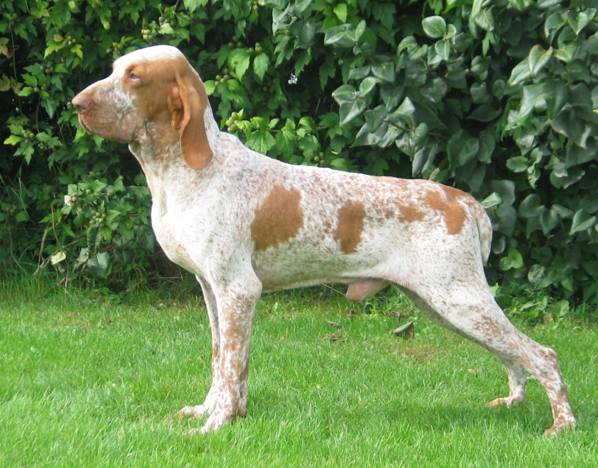Introduction
Hunters in northern and central Italy have relied on the Italian Pointer for centuries. The dog carries itself with grace, yet works hard in the field. It points game birds with speed, then waits for the hunter’s cue.
Families who enjoy an active life now welcome the breed into their homes as well. Understanding the basics of dog breed Italian Pointer helps owners give this athlete the life it deserves.
History and Origin
The Italian Pointer, also called the Bracco Italiano, is one of Europe’s oldest pointing breeds. Sculptures from the Renaissance show dogs that look almost the same as modern ones. Nobles prized their keen scent, great stamina, and steady point.
Over time, Italian hunters crossed lighter coursing hounds with heavier mastiff-type dogs. The result was a pointer able to work in marshes, hills, and thick cover.
By the early twentieth century, two regional types existed: the lighter Piedmont dog from the north and the sturdier Lombard dog from the south.
Dedicated breeders unified the lines, refined the head shape, and set clear standards. Today, international kennel clubs list the Italian Pointer in their sporting groups. Many hunters still prefer it because the dog ranges close, holds a firm point, and retrieves gently.
Appearance

Knowing the basics of dog breed Italian Pointer includes learning its build. Males stand 23 to 27 inches at the shoulder and weigh 70 to 90 pounds. Females run slightly smaller. The body is powerful but never bulky. The back is straight, the chest is deep, and the loin is strong.
The large, square muzzle shows well-developed lips that hang a little over the lower jaw. Soft, expressive eyes sit under a slight brow. Long, low-set ears frame the face and swing forward when the dog scents game.
Coat length is short and dense. Common colors are white and orange, white and chestnut, or white with roan ticking. Many dogs show a fully pigmented nose that matches coat patches. The coat needs only weekly brushing because dead hair falls away with ease.
Temperament
A sound Italian Pointer is calm indoors yet lively outdoors. It bonds deeply with family members and remains gentle with children. The dog’s original work required cooperation, so it still seeks guidance from its handler. That trait makes training smooth when the owner stays upbeat and consistent.
Because of their long history in packs, Italian Pointers often live peacefully with other dogs. They may chase cats or rabbits, but early socialization can limit this habit. Expect a courteous greeting when guests arrive, followed by relaxed watchfulness.
Exercise and Mental Stimulation
Energy output is a core part of the basics of dog breed Italian Pointer. These dogs want at least ninety minutes of activity each day. Long walks, off-leash runs, and field training sessions keep both body and mind sharp. They excel in scent work, tracking, and agility. Giving them a job curbs boredom and loud voice.
When owners hike or camp, the Italian Pointer carries itself with a steady trot and checks in often. In hot weather, water breaks prevent overheating because the breed’s deep chest holds heat longer than lighter dogs.

Training Tips
Start lessons as soon as the puppy arrives. Use praise, food, and play instead of harsh commands. Short drills that end on a win build trust. Teach “whoa” early; this command freezes the dog in a standing position, which is crucial in pointing work. Practice recall in fenced areas until flawless.
A front-clip harness works well for leash manners. Some owners compare different front-clip harness designs before picking one that sits low on the chest yet does not rub the dog’s shoulder — an approach explained in this guide on front-clip harness designs.
When the dog starts hunting, expose it to birds in a calm setting. Let instinct guide the first points instead of pushing the dog toward game. Mark correct posture with praise or a whistle. End each session while the dog still wants more.
Living Environment
The breed fits best in a home with a fenced yard. Because it jumps well and chases scent, a secure perimeter matters. Owners who want a hidden boundary can look at modern containment solutions that teach the dog safe limits without a physical fence.
Inside the house, the Italian Pointer enjoys soft bedding and stays close to people. It drools a bit after drinking, so keep a towel handy. Daily ear checks prevent infection because long ears trap moisture.
If the family uses an automated door system, choose a model that reads the dog’s collar tag. This keeps out stray animals while giving the pointer free access to the yard.
Conclusion
Knowing the basics of dog breed Italian Pointer prepares a family or hunter for a rewarding journey. The dog blends elegance with utility, grace with power, and gentleness with drive.
Provide steady leadership, regular exercise, and heartfelt praise, and the Italian Pointer will give back years of service and affection. For anyone who values a versatile gun dog and an engaging companion, this historic breed remains a fine choice.

